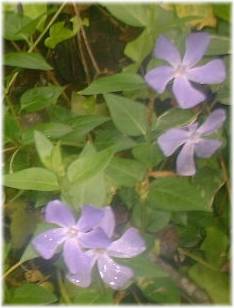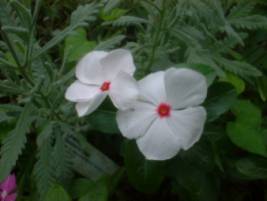|
Gardens Ablaze |
||
|
|
Periwinkle |
CLICK HERE for an exquisite selection of fire pits. |
|
Additional Periwinkle Information
Medicinal Uses Site Map
Home
|
Both vining types of Periwinkle will grow in full sun, but prefer a somewhat shady location, and will tolerate less than perfect soil if given adequate water. Full-sun will produce more flowers, but part-shade will produce better looking foliage. Stem cuttings are easy to root for those on a budget, and rooted cuttings spaced about 6 inches apart will cover the entire area by the end of the season. Blooms appear in April and sometimes again in fall with both types, and Vinca Major may also sporadically bloom throughout the summer. Interplanting with other reliable spring-flowering bulbs such as Daffodils will virtually guarantee a memorable and maintenance-free spring landscape. Plant Vinca Major and Minor at any point in time except the dead of winter. Break the soil up and maybe throw some compost or dried manure in to help the plants get established. From then on, water as needed, and weed until the plants become established, at which point they should choke out most of the weeds in the area. Fungus is occasionally a problem, so try not to water from overhead if at all possible. Once established, pull any renegades that overstep their bounds, and enjoy the show!
Rosy Periwinkle is a noteworthy medicinal herb, much more so than the other Vincas, though they also have a few medicinal qualities. Please see the link at the top left for more information.
Custom Search
|
|
|
Gardens Ablaze |
||
 If
you have a problem area in the landscape and are looking for a good-looking,
long-lasting, fast-growing, and virtually trouble-free ground cover, Periwinkles
(Vinca Major & Vinca Minor) may just be the perfect choice for you.
A member of the Dogbane family, and vining in habit, Periwinkle is not a
climber but is rather an evergreen
If
you have a problem area in the landscape and are looking for a good-looking,
long-lasting, fast-growing, and virtually trouble-free ground cover, Periwinkles
(Vinca Major & Vinca Minor) may just be the perfect choice for you.
A member of the Dogbane family, and vining in habit, Periwinkle is not a
climber but is rather an evergreen  Madagascar
or Rosy Periwinkle is a close relative of the ground cover Vinca but is
sold as an upright bedding plant (up to 18" in height). It is a tender
perennial that is treated as an annual in all but the warmest areas.
It is the exact opposite of its cousins in that it prefers full sun, rather
dry soil, hot conditions, and blooms all summer. Flower colors pretty
much range the spectrum, often with a contrasting "eye" as in the picture
above. Rosy Periwinkle is propagated by seed rather than cuttings,
and planted in masses makes a long-lasting, good-looking statement in the
landscape. It also lends itself well to
Madagascar
or Rosy Periwinkle is a close relative of the ground cover Vinca but is
sold as an upright bedding plant (up to 18" in height). It is a tender
perennial that is treated as an annual in all but the warmest areas.
It is the exact opposite of its cousins in that it prefers full sun, rather
dry soil, hot conditions, and blooms all summer. Flower colors pretty
much range the spectrum, often with a contrasting "eye" as in the picture
above. Rosy Periwinkle is propagated by seed rather than cuttings,
and planted in masses makes a long-lasting, good-looking statement in the
landscape. It also lends itself well to